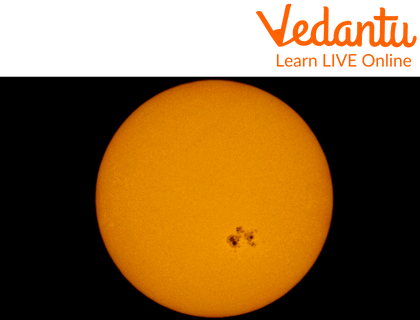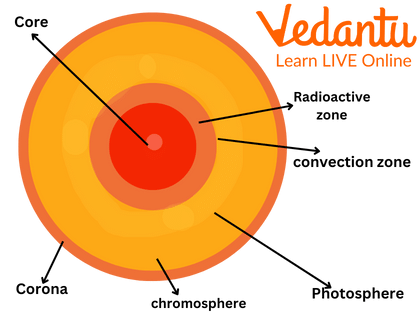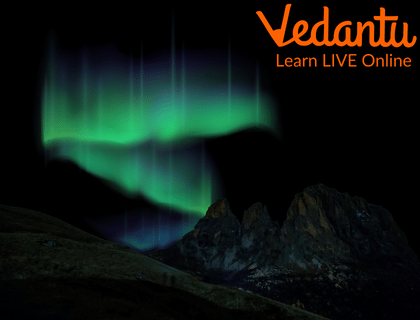




Introduction to Sunspots
The sun is the main source of light on the earth, it is also responsible for providing heat energy. If you observe the sun through a telescope, you will spot some dark areas on its surface. What do you think these are? They can be either small dark spots or large dark spots and are usually uneven and irregularly shaped. These areas or regions on the sun’s surface are known as Sunspots. Sunspots can be defined as the fine dark spots on the surface of the sun that are simply areas that have high and intense magnetic activity and thus these spots are capable of releasing a large amount of energy. In this article, we will study these dark sunspots, and their effects and state some fun and interesting facts about them.
What are Sunspots?
Sunspots are defined as large, dark and irregularly shaped spots that occur on the surface of the Sun. They occur in the photosphere region of the Sun. The photosphere is the visible surface of the sun from which most of the sunlight is emitted that reaches the Earth. These spots are lower in temperature than the surrounding surface temperatures. They are observed over regions of intense magnetic activity and huge amounts of energy are released from them. This energy results in the formation of Solar flares and Solar winds. The reason that Sunspots are relatively cool is that they form in areas with intense magnetic activity. These magnetic fields are so strong that they prevent the heat within the sun from reaching the surface. The magnetic field in such areas is about 2,500 times stronger than Earth’s.

Sunspots

Anatomy of the Sun
Effects of Sunspots
There are a lot of effects of sunspots that can be seen on the Earth or can be observed from it. Sunspots are responsible for the formation of Solar flares and Solar winds. They are also responsible for the Aurora formation. An increase in the number and size of sunspots also directly affects the Earth’s temperature. As they increase, they cause increased temperatures on the Earth which has negative implications for the climate and the environment. Radio Blackouts are also caused by Sunspots.
What are Solar Winds?
The solar wind is a stream of protons and electrons from the outermost atmosphere of the Sun called the corona. The charged particles that are emitted breeze through the solar system at speeds of around 250 miles(400 kilometres) per second to 500 miles(800 km) per second, in the state of plasma.
When the solar winds reach the Earth, they interact with its magnetosphere and produce vibrant and glowing aurora displays in the north and south poles. The aurora at the North pole is called the aurora borealis and the aurora at the south pole is called the aurora australis. Eugene Parker, an astrophysicist, was the first person who proposed the existence of solar winds. He put forward his theory in 1957 when he realised that the corona of the sun which is superheated should emit charged particles at high speed in theory.

Aurora
Facts About Sunspots
Some interesting facts about sunspots are:
Sunspots were first observed telescopically by Thomas Harriot, Johannes and David Fabricius in 1610 AD.
A sunspot is temporary and not permanent. It can last and be seen from days to weeks or months and it is also capable of travelling across the solar disk.
When two sunspots appear in the same region, it is called the sunspot group or the Active region.
Sunspots can vary in size from being several times larger than Earth(some as large as 50000 km in diameter) to being minuscule enough to observe by telescopes extremely difficult.
Sunspots typically consist of two regions called Umbra and Penumbra. The Umbra region is the dark region and the Penumbra region is the surrounding lighter region.

Umbra and Penumbra Region
Sunspot cycles last for 11 years. After each cycle, their numbers increase and then gradually start reducing.
Summary
Sunspots are interesting phenomena that occur on the surface of the sun. They are dark irregular-shaped spots that occur in the photosphere region of the Sun as a result of intense magnetic activity. They are responsible for several effects ranging from the formation of solar flares and solar winds to the formation of auroras in the polar regions of the Earth.
Learning by Doing
1) What is the inner dark region of the sunspot called?
Umbra
Penumbra
Photosphere
None of the above
Ans: a) Umbra
2) The aurora at the North pole is called the aurora ________ and the aurora at the south pole is called the aurora _________.
Ans: Borealis, Australis.
Solved Questions
1) Who proposed the existence of Solar winds first?
Ans: Eugene Parker
2) Who first observed the existence of sunspots?
Ans: Thomas Harriot, Johannes and David Fabricius in 1610 AD.
FAQs on Facts about Sunspots
1) What is the main cause of sunspots?
Sunspots are caused due to intense magnetic activity and disturbances in the photosphere region.
2) How long does a sunspot last?
Sunspots can last from a few hours to days or even months.
3) What is the sunspot cycle?
The sunspot cycle is the periodic increase and decrease of the number of sunspots after approximately 11 years.









